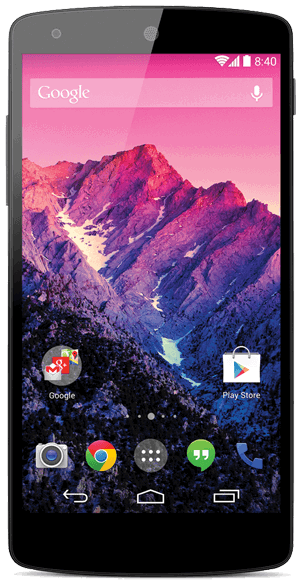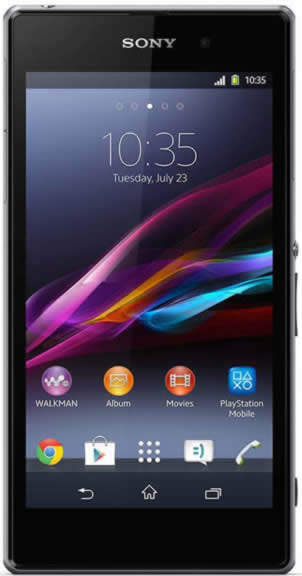|
Google, Sony smart phones a real alternative to AppleBy Jim Bray The assault on Apple's iPhone family continues, with new smart phones being introduced seemingly every week. And while most of these - especially ones that share an operating system - work basically the same, there are still many ways to differentiate competing phones. Take the two models in this piece for example. The Google Nexus 5 (which, at least as far as Telus' sample is concerned, is built by LG) may be the closest in form (if not iOS function) to the iPhone, while Sony's Xperia Z1 offers plenty of benefits in its own right, including the fact that you can skip it across a lake and it'll still work. Probably. Both phones use the Android operating system, 4.42 Kit Kat (upgraded from 4.4 during my test) in the Nexus and 4.2.2 Jelly Bean (upgraded to 4.3 during my time with it) in the Sony. I didn't notice a lot of fundamental difference between them - it isn't like the 4.3 version is like having an abacus compared to the 4.42 one - so I wouldn't sweat excessively about the Nexus being a bit more state-of-the-art than the Sony when it comes to its OS. But both phones are different enough that their features are worth comparing, the final decision between them of course being up to you. I have my favorite of the two, but that doesn't mean it's best for you. Let's start with the Nexus 5. I had to laugh when I first heard of it, because as a sci-fi movie fan its name is reminiscent of the classic Blade Runner, whose replicant adversaries were of the Nexus 6 persuasion. So if art does, indeed, mimic life, there must be one heckuva leap coming, technologically speaking, to go from an Android smart phone to a "real life android" in one step! Maybe it's time to buy shares in the Tyrell corporation! Anyway, the Nexus 5 is a darn nice phone. It appears to be nearly as, if not equally, well built as the iPhone, which is the standard by which I measure a smart phone. No cheap-feeling plastic here. Its exterior layout is straightforward, with a power button on the right hand side and volume control on the left, headphone jack on top and USB port on its bum. In this way, it's just like my old Samsung Galaxy S, except for the robustly built part and about four generations of smart phone technology. The phone's press material said the Nexus is designed "for the hardcore Fandroid," whatever the heck that means, and "for early adopters who are always seeking the latest and greatest device on the market." Hype notwithstanding, it's just an all-around great phone regardless of your geek factor. Telus is so gung ho on the thing that they're offering "Anytime Upgrades," making it easy for customers to switch before their term is up." I imagine there's a kilo of flesh in there somewhere, however, telcos being what they are. Still, it's nice to have choices. Highlights of the Nexus 5 include:
All of the stuff I tried on the phone worked as intended and the phone is more than adequate for most needs. Heck, I'm still using the old five megapixel camera on my older smart phone and find it just fine, so for my own needs (which includes some photography for the web), the Nexus would be more than adequate. Upping the image ante… The Sony Xperion Z1, on the other hand, raises the phone bar with a 20.7 megapixel camera "with added AR modes" that "allow you to take creative and amazing pictures," according to Sony. And it's very good but as I said, could be overkill for many people. Still, that's no reason not to like the phone! Sony says the Xperion uses its "award-winning G Lens" with a 27 mm wide angle and F2.0 aperture, coupled with other stuff to help ensure your photos are up to snuff. In fact, the company claims the combination of these technologies delivers a quality and performance equal to a conventional compact digital camera. As with the Nexus, the Xperia Z1's display boasts 1980 x 1080 resolution, but the company also said it includes proprietary stuff such as "Triluminos display" and "X-Reality Engine" which they say comes from their Bravia TV technology (which is no slouch itself) and is supposed to make the screen easier on the eyes. Maybe it's me, but I didn't see much difference, even when I put the same source on both phones. An edge to the Sony, but not a huge difference perhaps, unless you plan to watch videos - in which case I'd recommend a tablet anyway because of their larger screen sizes. Xperia also comes with camera applications such as "social live" (lets you broadcast from the phone to Facebook and brings your friends' snide retorts back on your screen) and "Info-eye" (a visual search function that gives you information on stuff such as books or wine by shooting them with the camera). And you can overlay a selection of "fun, customizable animations" to create pictures with what Sony calls its SmartARTM augmented reality technology. Really important stuff, this (kidding!). The phone also integrates "PlayMemories Online," a cloud-based image and video service and a new "All Sync" feature lets you auto-upload all of your photos, with no storage limitation. You also get "Walkman" (I'm surprised it isn't called "Walkperson" by now) and Movies applications that can give you access to "more than 22 million songs" through Music Unlimited and "more than 150K movies and TV series" through Video Unlimited from the Sony Entertainment Network. For free? What do you think? To be fair, the Xperia Z1 does offer five movies and "an exclusive movie access pass to the digital release of a Sony Pictures' summer blockbuster," and you get a two-month free trial of the Music Unlimited streaming service plus 10 games from PlayStation Mobile. To get you hooked. And Sony, whose name was inspired by the French word for "sound," also tosses in ClearAudio+, which they say optimizes the audio experience automatically, without the need to adjust individual settings. The phone appears to be built very well and though I preferred the smaller bezel of the Nexus, it's still plenty slim enough and fit well into my shirt pockets. Sony says it features a solid, one-piece aluminum frame with tempered glass front and rear. The sound quality of both phones is just fine, though I might give a slight edge to the Sony. I played some of my best digital files through both phones - using my Bose Quiet Comfort 20 noise cancelling ear buds and via Bluetooth to a variety of speakers - and was more than satisfied with both phones' audio performance. The Sony has a slightly larger footprint than the Nexus, which could cause some angst for those with wee paws, but it isn't a large difference. Its exterior layout is a lot different from the Nexus, though, undoubtedly thanks to its water-fighting mandate. There's a round power button on the right side with a volume rocker immediately below and on the left side there are two doors hiding the USB and smart card ports. The audio jack is on the top, basically where it is on the Nexus. All said, while I like the Sony a lot, I prefer the Nexus 5, basically because I found it more straightforward for my needs. For example, you have to open the little door on the side of the Sony to plug in its charger, whereas you only have to patch the Nexus into the USB port on its bottom and no prying open of doors is necessary. Not a big deal, but it meant I had to put on my reading glasses to fumble with the Sony's doors, whereas I could plug the Nexus in without resorting to my specs. These differences undoubtedly have something to do with the Xperia's "waterproofness," and that's great - but I don't care about it being waterproof, so that feature's a waste to me. But if it's important to you, you'll probably be glad to know that Sony claims you can immerse the thing in fresh water for up to half an hour - so you won't short it out when taking pictures of the kids in the local swimming pool. Sony does warn you to keep the covers closed firmly, which makes sense. You're also admonished to keep the Xperia away from salt water, liquid chemicals and sand or mud. So it's waterproof depending on the water… And here's something: both units also work as phones! Who'd have thunk? Either of these phones will do a great job for you. They're both up to date, packed with great features, and work pretty much as advertised. So while I'm more "hung up" on the Nexus, you can't really go far wrong with the Sony either. Copyright 2014 Jim Bray Jim Bray's columns are available through the TechnoFile Syndicate. We welcome your comments! |
|
|||||

